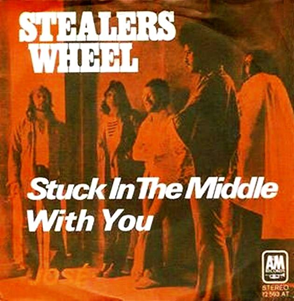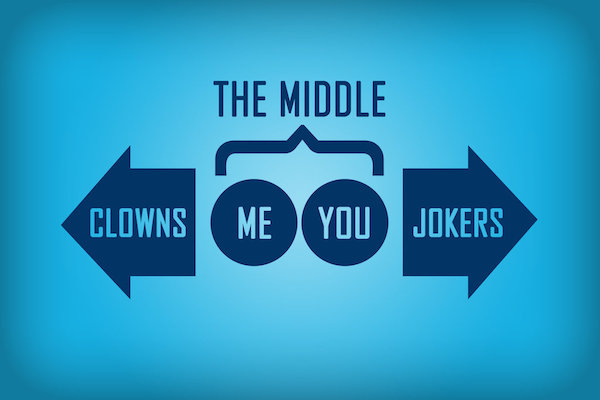William Smead: "Stuck in the middle with you"
by William Smead, Smead Capital Management
Unless you have been asleep on the floor for the last six weeks, you’ve noticed that the U.S. stock market has gone down. Even before stocks sold off in August, the average common stock had been performing poorly relative to the S&P 500 Index. In August, the market officially declined more than 10% from peak to trough. An anthem for situations like this comes from the one-hit wonder, Stealers Wheel, who penned the song “Stuck in the Middle with You.” Here is how the song described a circumstance like the one we have in the stock market currently:
Well I don’t know why I came here tonight,
I got the feelin’ that somethin’ ain’t right,
I’m so scared in case I fall off my chair,
And I’m wonderin’ how I’ll get down the stairs
When investors in common stocks get into a market decline period they wonder “why I came here tonight.” Stock market corrections are just as important to long-term investment success as positive market movements. The primary reason that long duration common stock ownership produces above average returns is because the results aren’t handed out in a straight line. In essence, long-duration ownership gets rewarded for patience through volatility. We “came here” looking for returns well above other liquid investments.
When you are in as volatile of a period as we are now (September 9, 2015), most investors look to experts and the media to make sense of what is going on in the stock market because “they have the feeling that something ain’t right.” Is the problem China’s economic slowdown, the Federal Reserve Board’s potential rate hikes? Do the uncomfortable feelings come from plummeting oil/commodity prices or the fact that the stock market has gone up a great deal since the bottom in March of 2009? Are common stocks overvalued on a P/E basis? These factors make the average individual and institutional investor “so scared in case [they] fall off [their] chair.”
How scared are investors? Both the American Association of Individual Investors and the Investor’s Intelligence poll of newsletter writers have recently registered polling numbers similar to March of 2009 near the bottom of the worst bear market since the 1930s. Most investors are wondering how they’ll “get downstairs.” Downstairs from a correction is a bear market decline of greater than 20%. Stealers Wheel continues:
Yes I’m stuck in the middle with you,
And I’m wondering what it is I should do,
It’s so hard to keep this smile from my face,
Losing control, yeah, I’m all over the place,
Are you “wondering what it is we should do?” As contrarians, we relish these corrective declines in the U.S. stock market. We use declines in the stock market to upgrade the quality of our portfolio and to concentrate our portfolio in the companies in which we have the most confidence. As we match up our buying with the story being told by insider buys from officers and directors of the companies we own, “it is hard to keep the smile from my face.”
Besides the great sentiment and the insider buying we are seeing, the fear created by other investors “losing control” has caused interest rates to stay low and oil prices to decline sharply. We use Ben Graham’s revised formula as a guidepost for determining intrinsic value. He researched interest rates on ten-year AAA-corporate bonds from 1944-1973 and concluded that the rate averaged 4.4% during those years. In his formula, the interest rate effect on intrinsic value is measured by dividing the numerator of 4.4 by the current AAA-bond rate.
While everyone seems to be “all over the place,” we focus in on Graham’s formula. Just compare the difference in intrinsic value at a rate of 2.5% versus 5.5%. A rate of 5.5% cuts the intrinsic value by 20%, while a rate of 2.5% raises the intrinsic value by 76%. Therefore, the intrinsic value of a company is more than 100% higher at 2.5% than it is at 5.5%. Let me repeat myself, the company’s future earnings are worth twice as much. Today’s ten-year AAA corporate bond averages 2.85%!
It’s this kind of reasoning that allows investors like Warren Buffett to remain bullish on the U.S. stock market. In a September 8, 2015 CNBC interview with Becky Quick, he said, “I have no idea where stocks will go in 6 months or a year, but with interest rates at these levels, we could see stocks go up a lot in five years and ten years.”
Trying to make some sense of it all,
But I can see that it makes no sense at all,
Is it cool to go to sleep on the floor,
‘Cause I don’t think that I can take anymore
Clowns to the left of me, jokers to the right,
Here I am, stuck in the middle with you
Many are “trying to make sense” of the oil market and are extrapolating its weakness as a sign of national and international economic anemia. Stealers Wheel had the answer, “But I can see that it makes no sense at all.” Most American lives are significantly improved by inexpensive energy since lower oil and gasoline prices are like a tax cut for millions of folks in almost all developed economy countries.
The history of the oil industry is meteoric booms followed by catastrophic busts. What most investors don’t realize is that the industry can “go to sleep on the floor.” Oil peaked in 1981 and bottomed in 1999 at $11 per barrel. It spiked to $40 in 1990 on the eve of the first Gulf War and immediately headed back into the teens. The industry can go dead for a long time and there is nothing that makes an investor feel like a “clown” more than being five to ten years early on a cheap and out of favor sector of the S&P 500 Index.
We are “stuck in the middle” of the stock market with companies which fit our eight criteria for stock selection and trade at well less than their intrinsic value at much higher interest rates than exist today. Our favorite sectors are extremely contentious and “don’t make sense” to most other investors. This includes financial service companies like American Express (AXP) and Bank of America (BAC), which other investors wonder “why we came here tonight.”
We like two big biotech companies: Amgen (AMGN) and Gilead Sciences (GILD). We believe the risk on, risk off nature of this correction has once again thrown babies out with the bathwater. Some of the trading in sector ETFs unduly affects their largest holdings and makes owners of large quality biotech’s look temporarily like “Jokers.”

Warm Regards,

The information contained in this missive represents SCM’s opinions, and should not be construed as personalized or individualized investment advice. Past performance is no guarantee of future results. It should not be assumed that investing in any securities mentioned above will or will not be profitable. A list of all recommendations made by Smead Capital Management within the past twelve month period is available upon request.
This Missive and others are available at smeadcap.com















